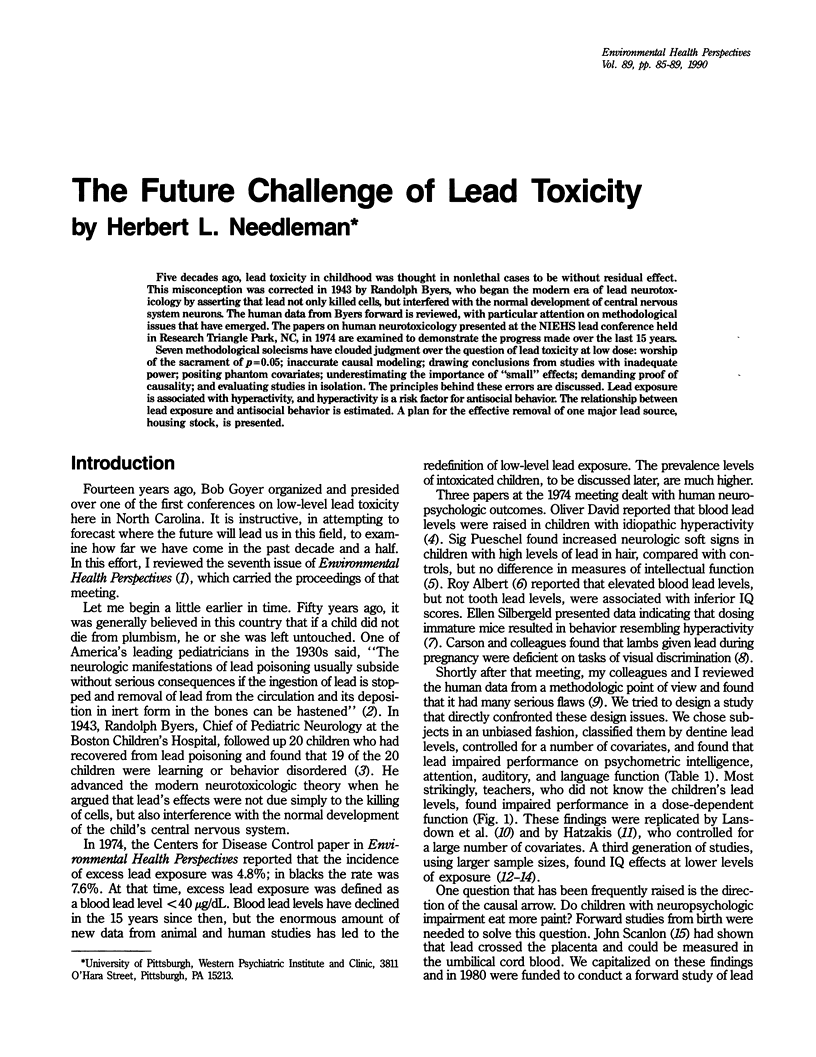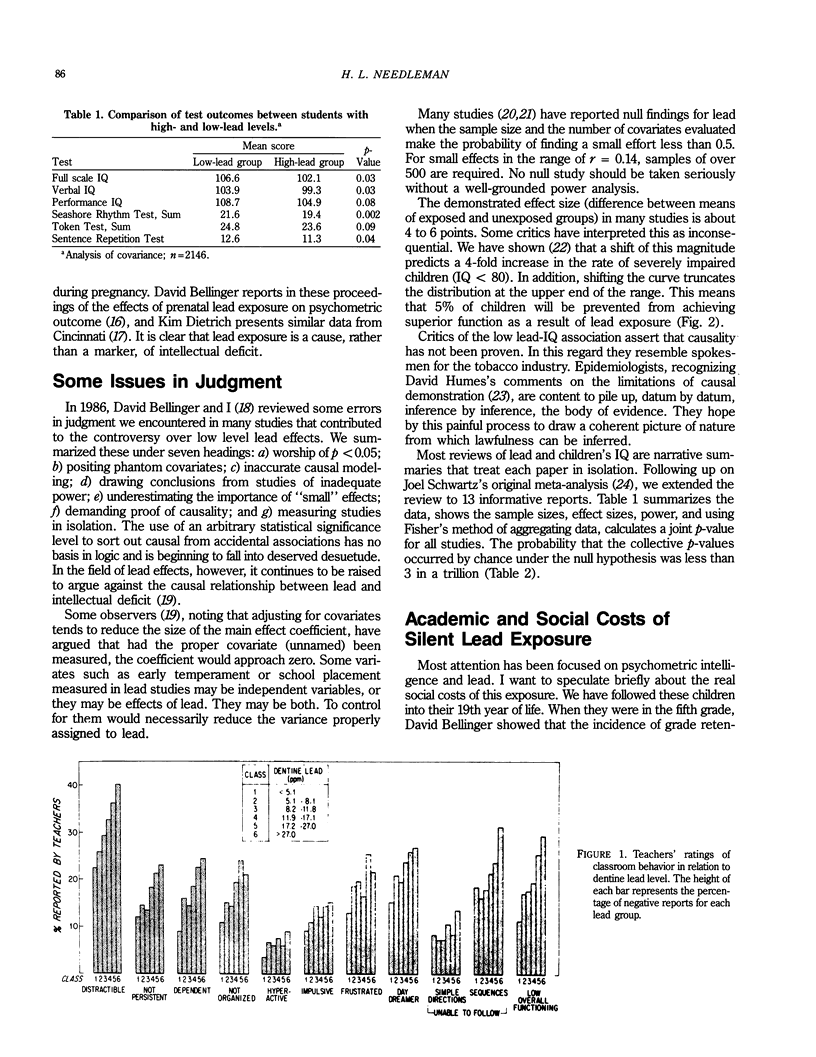Abstract
Five decades ago, lead toxicity in childhood was thought in nonlethal cases to be without residual effect. This misconception was corrected in 1943 by Randolph Byers, who began the modern era of lead neurotoxicology by asserting that lead not only killed cells, but interfered with the normal development of central nervous system neurons. The human data from Byers forward is reviewed, with particular attention on methodological issues that have emerged. The papers on human neurotoxicology presented at the NIEHS lead conference held in Research Triangle Park, NC, in 1974 are examined to demonstrate the progress made over the last 15 years. Seven methodological solecisms have clouded judgment over the question of lead toxicity at low dose: worship of the sacrament of p = 0.05; inaccurate causal modeling; drawing conclusions from studies with inadequate power; positing phantom covariates; underestimating the importance of "small" effects; demanding proof of causality; and evaluating studies in isolation. The principles behind these errors are discussed. Lead exposure is associated with hyperactivity, and hyperactivity is a risk factor for antisocial behavior. The relationship between lead exposure and antisocial behavior is estimated. A plan for the effective removal of one major lead source, housing stock, is presented.
Full text
PDF




Selected References
These references are in PubMed. This may not be the complete list of references from this article.
- Bellinger D., Leviton A., Sloman J. Antecedents and correlates of improved cognitive performance in children exposed in utero to low levels of lead. Environ Health Perspect. 1990 Nov;89:5–11. doi: 10.1289/ehp.90895. [DOI] [PMC free article] [PubMed] [Google Scholar]
- Carson T. L., Van Gelder G. A., Karas G. G., Buck W. B. Development of behavioral tests for the assessment of neurologic effects of lead in sheep. Environ Health Perspect. 1974 May;7:233–237. doi: 10.1289/ehp.747233. [DOI] [PMC free article] [PubMed] [Google Scholar]
- David O. J. Association between lower level lead concentrations and hyperactivity in children. Environ Health Perspect. 1974 May;7:17–25. doi: 10.1289/ehp.74717. [DOI] [PMC free article] [PubMed] [Google Scholar]
- Dietrich K. N., Succop P. A., Bornschein R. L., Krafft K. M., Berger O., Hammond P. B., Buncher C. R. Lead exposure and neurobehavioral development in later infancy. Environ Health Perspect. 1990 Nov;89:13–19. doi: 10.1289/ehp.908913. [DOI] [PMC free article] [PubMed] [Google Scholar]
- Ernhart C. B., Landa B., Wolf A. W. Subclinical lead level and developmental deficit: re-analyses of data. J Learn Disabil. 1985 Oct;18(8):475–479. doi: 10.1177/002221948501800807. [DOI] [PubMed] [Google Scholar]
- Harvey P. G., Hamlin M. W., Kumar R., Delves H. T. Blood lead, behaviour and intelligence test performance in preschool children. Sci Total Environ. 1984 Dec;40:45–60. doi: 10.1016/0048-9697(84)90341-3. [DOI] [PubMed] [Google Scholar]
- Hawk B. A., Schroeder S. R., Robinson G., Otto D., Mushak P., Kleinbaum D., Dawson G. Relation of lead and social factors to IQ of low-SES children: a partial replication. Am J Ment Defic. 1986 Sep;91(2):178–183. [PubMed] [Google Scholar]
- Lansdown R., Yule W., Urbanowicz M. A., Hunter J. The relationship between blood-lead concentrations, intelligence, attainment and behaviour in a school population: the second London study. Int Arch Occup Environ Health. 1986;57(3):225–235. doi: 10.1007/BF00405790. [DOI] [PubMed] [Google Scholar]
- Nation J. R., Baker D. M., Bratton G. R., Fantasia M. A., Andrews K., Womac C. Ethanol self-administration in rats following exposure to dietary cadmium. Neurotoxicol Teratol. 1987 Sep-Oct;9(5):339–344. doi: 10.1016/0892-0362(87)90028-6. [DOI] [PubMed] [Google Scholar]
- Needleman H. L., Gunnoe C., Leviton A., Reed R., Peresie H., Maher C., Barrett P. Deficits in psychologic and classroom performance of children with elevated dentine lead levels. N Engl J Med. 1979 Mar 29;300(13):689–695. doi: 10.1056/NEJM197903293001301. [DOI] [PubMed] [Google Scholar]
- Needleman H. L., Leviton A., Bellinger D. Lead-associated intellectual deficit. N Engl J Med. 1982 Feb 11;306(6):367–367. doi: 10.1056/NEJM198202113060618. [DOI] [PubMed] [Google Scholar]
- Pueschel S. M. Neurological and psychomotor functions in children with an increased lead burden. Environ Health Perspect. 1974 May;7:13–16. doi: 10.1289/ehp.74713. [DOI] [PMC free article] [PubMed] [Google Scholar]
- Scanlon J. Umbilical cord blood lead concentration. Relationship to urban or suburban residency during gestation. Am J Dis Child. 1971 Apr;121(4):325–326. [PubMed] [Google Scholar]
- Silbergeld E. K., Goldberg A. M. Hyperactivity: a lead-induced behavior disorder. Environ Health Perspect. 1974 May;7:227–232. doi: 10.1289/ehp.747227. [DOI] [PMC free article] [PubMed] [Google Scholar]
- Silbergeld E. K., Goldberg A. M. Hyperactivity: a lead-induced behavior disorder. Environ Health Perspect. 1974 May;7:227–232. doi: 10.1289/ehp.747227. [DOI] [PMC free article] [PubMed] [Google Scholar]
- Winneke G., Hrdina K. G., Brockhaus A. Neuropsychological studies in children with elevated tooth-lead concentrations. I. Pilot study. Int Arch Occup Environ Health. 1982;51(2):169–183. doi: 10.1007/BF00378161. [DOI] [PubMed] [Google Scholar]
- Winneke G., Krämer U., Brockhaus A., Ewers U., Kujanek G., Lechner H., Janke W. Neuropsychological studies in children with elevated tooth-lead concentrations. II. Extended study. Int Arch Occup Environ Health. 1983;51(3):231–252. doi: 10.1007/BF00377755. [DOI] [PubMed] [Google Scholar]
- Yule Q., Lansdown R., Millar I. B., Urbanowicz M. A. The relationship between blood lead concentrations, intelligence and attainment in a school population: a pilot study. Dev Med Child Neurol. 1981 Oct;23(5):567–576. doi: 10.1111/j.1469-8749.1981.tb02038.x. [DOI] [PubMed] [Google Scholar]


